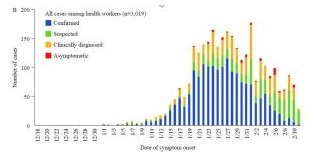COVID-19: Will the tens of thousands of infected health care workers be recognized at the May 18-19 World Health Assembly?
Facebook Twitter LinkedIn EmailThe initial wave of the SARS-CoV-2/COVID-19 pandemic includes tens of thousands of health care workers in less than five months. Reports of health care worker infections began in China in January and spread globally elsewhere in Asia, Europe, the Middle East, the Americas, Africa, Iran, the USA, Russia, and beyond.
Will the World Health Assembly this week recognize this health care worker-epidemic-within-the-pandemic and reemphasize feasible precautions for health care providers as the imminent 'influenza plus Covid-19 winter’ June-August 2020 high-tide waves arrive in the southern hemisphere?
On Jan. 20, 2020 Dr. Zhang Nanshan, the renowned expert on SARS from 2003 and now SARS-CoV-2, announced that 15 health care workers had been infected in one Wuhan hospital related to the intubation of a patient. The first comprehensive report of health care worker exposure in China appeared in a press conference on Feb. 14, and subsequently in publications in the China Center for Disease Control Weekly and China Journal of Epidemiology. As shown below in the China CDC Weekly publication online (February 17, Vol 2 /No.8, Figure 4, page 119), the time course from Jan. 1 through Feb. 11 details the onset of symptoms 3,019 infected health care workers (1,716 confirmed):
In the same China CDC Weekly, data on laboratory-confirmed cases were presented in table 2, page 120. Of note, in this table (see below) there were already 330 confirmed cases in China with a date of onset between Jan. 1 and Jan. 20. In the ten days from Jan. 21-31 there were a stunning 1,036 confirmed cases.
Figures and tables with thousands of infected persons must not in translation lose the searing reality that each number represents a human being.
A poignant example of the threat to health care workers during this pandemic is Dr. Li Wengjiang, the 34-year-old ophthalmologist who sounded the alarm about a possible SARS-like contagious pneumonia and was among the initial health care workers infected. He died of COVID-19 in Wuhan on Feb 6 (Feb 7 in China).
In the United States, the U.S. Centers for Disease Control and Prevention published in their Morbidity and Mortality Weekly Report April 17, Vol 69/No. 15 pages 479-481 a report titled: “Characteristics of Health Care Personnel with COVID-19—United States February 12-April 9, 2020.” Of note, their reported 9,282 (19%) infected health care workers out of 49,370 cases was surely an underestimate. We extrapolate from the data below that the total number of infected U.S. health care workers is over 10,000.
“During February 12–April 9, among 315,531 COVID-19 cases reported to CDC using a standardized form, 49,370 (16%) included data on whether the patient was a health care worker in the United States; including 9,282 (19%) who were identified as [health care workers].”
Other nations, especially in parts of Europe such as Italy and Spain, have reported over 10,000 health care workers infected. We are not aware of the numbers of infected health care workers being posted by the WHO on their Covid-19 website. Per CDC reports, the number of infected health care workers in the U.S. is expected to rise. This prediction will undoubtedly be reflected worldwide without the availability of feasible precautions. The importance of data collection and weekly tracking of health care worker infection cannot be over-emphasized. It would be helpful for WHO to post updates, at least every month, of the numbers of infected health care workers globally and by individual nations.
Will the World Health Assembly recognize this health care worker-epidemic-within-the-pandemic?




